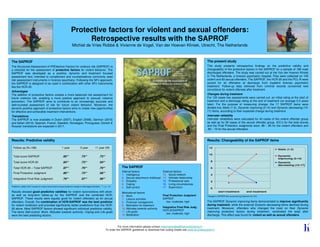
SAPROF Protective Factors for Violence Risk. Retrospective Results Violent and Sexual Offenders. Poster 2011
- 1. Protective factors for violent and sexual offenders: Retrospective results with the SAPROF Michiel de Vries Robbé & Vivienne de Vogel, Van der Hoeven Kliniek, Utrecht, The Netherlands The SAPROF The present study The Structured Assessment of PROtective Factors for violence risk (SAPROF) is This study presents retrospective findings on the predictive validity and a checklist for the assessment of protective factors for violent behavior. The changeability of the protective factors in the SAPROF for a sample of 188 male SAPROF was developed as a positive, dynamic and treatment focused discharged offenders. The study was carried out at the Van der Hoeven Kliniek assessment tool, intended to complement and counterbalance commonly used in The Netherlands, a forensic psychiatric hospital. Files were collected on 105 risk assessment instruments in forensic psychiatry. Following the SPJ approach, violent and 83 sexual offenders. The SAPROF, the HCR-20 and the PCL-R were the SAPROF is designed to be used in combination with other SPJ instruments scored for all offenders at discharge from inpatient forensic psychiatric like the HCR-20. treatment. Follow-up data retrieved from criminal records concerned new convictions for violent offenses after treatment. Advantages The addition of protective factors creates a more balanced risk assessment for Changes during treatment future violence risk, enabling a more positive approach to (sexual) violence For 120 cases two assessments were carried out: an initial rating at the start of prevention. The SAPROF aims to contribute to an increasingly accurate and treatment and a discharge rating at the end of treatment (on average 5.5 years well-rounded assessment of risk for future violent behavior. Moreover, the later). For the purpose of measuring change, the 17 SAPROF items were dynamic positive approach of protective factors aims to create new opportunities divided into Static (1-2), Dynamic improving (3-14) and Dynamic decreasing (15- for effective and achievable treatment interventions. 17) items, according to their expected change during treatment. Translations Interrater reliability The SAPROF is now available in Dutch (2007), English (2009), German (2010) Interrater reliabilities were calculated for 40 cases of the violent offender group and Italian (2010). Spanish, French, Swedish, Norwegian, Portuguese, Danish & as well as for 30 cases of the sexual offender group. ICC’s for the total scores Russian translations are expected in 2011. and the Final Protection Judgments were .88 / .85 for the violent offenders and .85 / .73 for the sexual offenders. Results: Predictive validity Results: Changeability of the SAPROF items Follow-up (N=188) 1 year 3 year 11 year (M) 12 Static (1-2) 10 Total score SAPROF .85** .75** .73** Dynamic improving (3-14) Total score HCR-20 .84** .73** .64** 8 Dynamic decreasing (15-17) Total HCR-20 – Total SAPROF .87** .76** .70** The SAPROF 6 Internal factors External factors Final Protection Judgment .80** .72** .66** 1. Intelligence 13. Social network 4 Integrative Final Risk Judgment .79** .67** .66** 2. Secure attachment childhood 14. Intimate relationship 3. Empathy 15. Professional care 2 4. Coping 16. Living circumstances Predictive validity (AUC-values) for violent reconvictions of post-treatment ratings for discharged offenders, ** = p < .01. 17. Supervision 5. Self-control 0 Results showed good predictive validities for violent reconvictions with short- Motivational factors start treatment end treatment as well as long-term follow-up for the SAPROF and the combined HCR- 6. Work Final Protection Judgment Changes in SAPROF item scores during treatment (N=120). SAPROF. These results were equally good for violent offenders as for sexual 7. Leisure activities SAPROF offenders. Overall, the combination of HCR-SAPROF was the best predictor 8. Financial management low, moderate, high The SAPROF Dynamic improving items demonstrated to improve significantly for violent recidivism and provided significantly better predictions than the HCR- 9. Motivation for treatment during treatment, while the external Dynamic decreasing items declined during Integrative Final Risk Judg. treatment. Moreover, offenders who changed the most on their Dynamic 20 alone. Most SAPROF factors showed significant individual predictive validity. 10. Attitudes towards authority HCR-20/SAPROF The items Self-control, Work, Attitudes towards authority, Coping and Life goals 11. Life goals improving protective factors during treatment, recidivated the least after low, moderate, high were the best predicting factors. 12. Medication discharge. This effect was found for violent as well as sexual offenders. For more information please contact mdevriesrobbe@hoevenstichting.nl To order the SAPROF guidelines or download free coding sheets see www.forumeducatief.nl